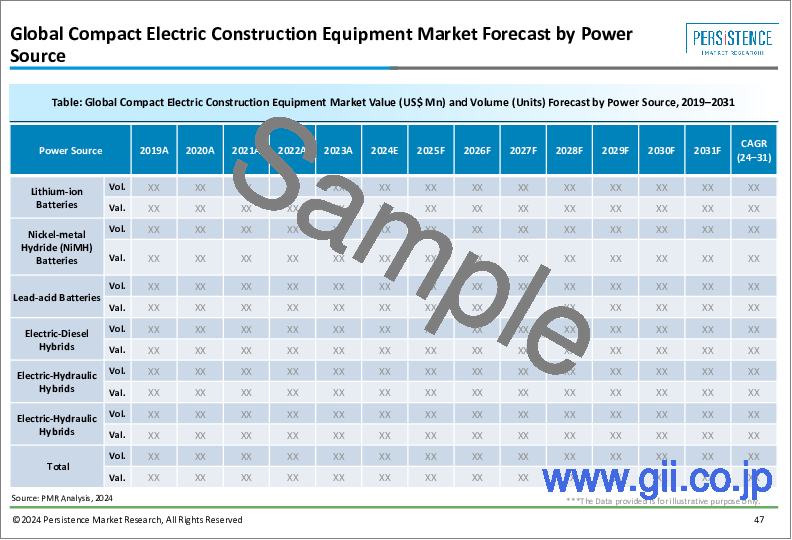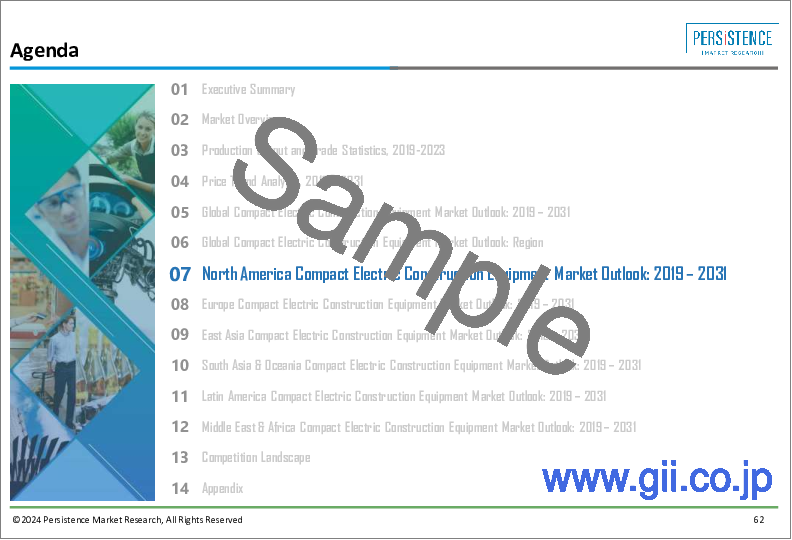|
|
市場調査レポート
商品コード
1482438
小型電動建設機械市場:地域別(北米、欧州、アジア太平洋、ラテンアメリカ、中東アフリカ):世界の産業分析、規模、シェア、成長、動向、2024-2032年予測Compact Electric Construction Equipment Market By Geography (North America, Europe, Asia Pacific, Latin America, and the Middle East and Africa): Global Industry Analysis, Size, Share, Growth, Trends, and Forecast, 2024-2032 |
||||||
カスタマイズ可能
|
|||||||
| 小型電動建設機械市場:地域別(北米、欧州、アジア太平洋、ラテンアメリカ、中東アフリカ):世界の産業分析、規模、シェア、成長、動向、2024-2032年予測 |
|
出版日: 2024年05月16日
発行: Persistence Market Research
ページ情報: 英文 333 Pages
納期: 2~5営業日
|
全表示
- 概要
- 目次
Persistence Market Research社は、小型電動建設機械市場の詳細な分析を発表し、その複雑なダイナミクスと将来の軌道に関する洞察を提供します。市場動向から成長触媒、阻害要因、新興パターンまで、本レポートは2024年から2032年までの貴重な統計と予測を提供します。
主な洞察
- 小型電動建設機械の市場規模(2024年):669億米ドル
- 市場予測値(2032年):1,778億米ドル
- 世界市場成長率(CAGR 2024年~2032年):15.1%
小型電動建設機械市場-調査範囲:
小型電動建設機械市場には、建設、インフラ開発、都市計画などの産業にわたる様々な用途が含まれます。この市場には、電動掘削機、ローダー、コンパクターなどの様々な機器が含まれます。市場成長の原動力は、技術の進歩、環境規制、持続可能な建設ソリューションに対する需要の高まりなどの要因です。
市場促進要因:
世界の小型電動建設機械市場は、いくつかの主要成長促進要因によって支えられています。電動パワートレイン・システムの技術的進歩は、建設機械の性能と効率を高め、様々なプロジェクトでの採用を促進します。さらに、厳しい環境規制と二酸化炭素排出量削減への世界の取り組みが、電気式建設機械への大きな需要を生み出しています。さらに、持続可能な建設慣行が重視されるようになったことで、研究開発活動が活発化し、革新的で環境に優しい機器の開発につながっています。
市場抑制要因:
有望な成長見通しにもかかわらず、小型電動建設機械市場は、初期コストの高さ、バッテリーの限界、インフラ要件に関連する課題に直面しています。従来のディーゼルエンジン駆動の機械と比べて電気建設機械のコストが高いことは、市場の成長を阻害する可能性があります。さらに、バッテリーの寿命と充電インフラの限界は、建設現場で継続的に使用するための運用上の課題となります。さらに、充電インフラへの多額の投資が必要なことも、運用コストと市場の不確実性を高めています。
市場機会:
小型電動建設機械市場は、技術革新、業界提携、市場の多様化によって有利な成長機会をもたらします。スマート建設、テレマティクス、自動化などの新たな動向は、メーカーに電気建設機械の新技術とアプリケーションの探求を促します。さらに、戦略的パートナーシップ、調査協力、M&Aにより、市場プレーヤーは製品ポートフォリオを拡大し、技術力を強化し、主要地域での市場プレゼンスを強化することができます。さらに、持続可能なインフラ整備のための政府支援の増加と相まって、研究開発への投資が増加しており、市場の拡大と多様化を促進する環境が整っています。
本レポートで扱う主な質問
- 小型電動建設機械市場の世界的成長を促進する主な要因は何か?
- 技術進歩や業界動向は電動建設機械の進化をどのように形成しているか?
- 電動建設機械分野の市場参入企業が直面する主な課題と機会は何か?
- 電気建設機械メーカーに最も高い成長の可能性を提供する産業分野と地域はどこか?
- 大手企業はどのような戦略で電気建設機械の差別化を図り、競合情勢の中で市場シェアを獲得しているのか?
目次
第1章 エグゼクティブサマリー
第2章 市場概要
- 市場範囲/分類
- 市場の定義/範囲/制限
第3章 市場背景
- 市場力学
- シナリオ予測
- 機会マップ分析
- 製品ライフサイクル分析
- サプライチェーン分析
- 投資実現可能性マトリックス
- バリューチェーン分析
- PESTLEとポーター分析
- 規制状況
- 地域親市場見通し
- 生産・消費統計
- 輸入と輸出の統計
第4章 世界の小型電動建設機械市場分析
- 過去の市場規模(金額および数量)分析、2019-2023
- 現在および将来の市場規模(金額および数量)予測、2024~2032年
第5章 製品タイプ別:世界の小型電動建設機械市場分析
- イントロダクション/主な調査結果
- 過去の市場規模(金額および数量)分析、2019-2023年
- 現在および将来の市場規模(金額および数量)分析・予測、2024-2032年
- フォークリフト
- ローダ
- 掘削機
- オーストラリア
- 前年比成長動向分析、2019~2023年
- 絶対的収益の機会分析、2024~2032年
第6章 アプリケーション別:世界の小型電動建設機械市場分析
- イントロダクション/主な調査結果
- 過去の市場規模(金額および数量)分析、2019-2023年
- 現在および将来の市場規模(金額および数量)分析・予測、2024-2032年
- 建設
- 鉱業
- 農業
- その他
- 前年比成長動向分析、2019~2023年
- 絶対的収益の機会分析、2024~2032年
第7章 地域別:世界の小型電動建設機械市場分析
- イントロダクション
- 過去の市場規模(金額および数量)分析、2019-2023年
- 現在の市場規模(金額および数量)分析・予測、2024-2032年
- 北米
- ラテンアメリカ
- 欧州
- アジア太平洋地域
- 中東・アフリカ
- 地域別市場魅力度分析
第8章 北米の小型電動建設機械市場分析(国別)
第9章 ラテンアメリカの小型電動建設機械市場分析(国別)
第10章 欧州の小型電動建設機械市場分析(国別)
第11章 アジア太平洋地域の小型電動建設機械市場分析(国別)
第12章 中東・アフリカの小型電動建設機械市場分析(国別)
第13章 主要国の小型電動建設機械市場分析
- 米国
- カナダ
- ブラジル
- メキシコ
- ドイツ
- 英国
- フランス
- スペイン
- イタリア
- マレーシア
- インド
- タイ
- シンガポール
- GCC諸国
- 南アフリカ
- イスラエル
第14章 市場構造分析
- 競合ダッシュボード
- 競合ベンチマーク
- 主要企業の市場シェア分析
第15章 競合分析
- 競合の詳細
- Caterpillar
- JCB
- HAULOTTE GROUP
- Wacker Neuson SE
- Toyota Motor Corporation
- Hyster-Yale Group, Inc.
- SANY Group
- Volvo CE
- Hyundai CE
- Bobcat
第16章 使用される前提条件と頭字語
第17章 調査手法
Persistence Market Research presents an in-depth analysis of the Compact Electric Construction Equipment Market, offering insights into its intricate dynamics and future trajectory. From market trends to growth catalysts, impediments, and emerging patterns, this report furnishes invaluable statistics and projections spanning from 2024 to 2032.
Key Insights:
- Compact Electric Construction Equipment Market Size (2024): USD 66.9 Billion
- Projected Market Value (2032): USD 177.8 Billion
- Global Market Growth Rate (CAGR 2024 to 2032): 15.1%
Compact Electric Construction Equipment Market - Report Scope:
The Compact Electric Construction Equipment Market encompasses various applications across industries such as construction, infrastructure development, and urban planning. This market includes a range of equipment such as electric excavators, loaders, and compactors. Market growth is driven by factors such as technological advancements, environmental regulations, and the increasing demand for sustainable construction solutions.
Market Growth Drivers:
The global Compact Electric Construction Equipment Market is bolstered by several key growth drivers. Technological advancements in electric powertrain systems enhance the performance and efficiency of construction equipment, driving its adoption across various projects. Moreover, stringent environmental regulations and the global push towards reducing carbon emissions create significant demand for electric construction equipment. Additionally, the growing emphasis on sustainable construction practices stimulates research and development activities, leading to the development of innovative, eco-friendly equipment.
Market Restraints:
Despite its promising growth prospects, the Compact Electric Construction Equipment Market faces challenges related to high initial costs, battery limitations, and infrastructure requirements. The high cost of electric construction equipment compared to traditional diesel-powered machinery can impede market growth. Furthermore, limitations in battery life and charging infrastructure pose operational challenges for continuous use in construction sites. Additionally, the need for substantial investments in charging infrastructure adds to operational costs and market uncertainties.
Market Opportunities:
The Compact Electric Construction Equipment Market presents lucrative growth opportunities driven by technological innovation, industry collaborations, and market diversification. Emerging trends such as smart construction, telematics, and automation inspire manufacturers to explore new technologies and applications for electric construction equipment. Moreover, strategic partnerships, research collaborations, and mergers and acquisitions enable market players to expand their product portfolios, enhance their technical capabilities, and strengthen their market presence in key regions. Furthermore, growing investments in research and development, coupled with increasing government support for sustainable infrastructure development, create a conducive environment for market expansion and diversification.
Key Questions Answered in the Report:
- What are the primary factors driving the growth of the Compact Electric Construction Equipment Market globally?
- How are technological advancements and industry trends shaping the evolution of electric construction equipment?
- What are the key challenges and opportunities facing market participants in the electric construction equipment segment?
- Which industrial sectors and geographic regions offer the highest growth potential for electric construction equipment manufacturers?
- What strategies are leading companies employing to differentiate their electric construction equipment offerings and capture market share in the competitive landscape?
Competitive Intelligence and Business Strategy:
Leading players in the global Compact Electric Construction Equipment Market, including construction equipment manufacturers and technology firms, focus on innovation, product differentiation, and market expansion to gain a competitive edge. These companies invest in research and development to develop advanced electric powertrain systems, improve equipment efficiency, and explore new applications for electric construction equipment. Moreover, strategic collaborations with research institutions, academic partners, and industry associations enable market players to access new technologies, expand their knowledge base, and accelerate product development efforts. Furthermore, emphasis on sustainability, regulatory compliance, and corporate social responsibility initiatives enhances brand reputation and fosters long-term relationships with customers and stakeholders.
Key Companies Profiled:
- Caterpillar Inc.
- Komatsu Ltd.
- Volvo Construction Equipment
- Hitachi Construction Machinery Co., Ltd.
- JCB
- Liebherr Group
- Doosan Bobcat Inc.
- SANY Group
- Hyundai Construction Equipment
- CNH Industrial N.V.
- Wacker Neuson SE
- Takeuchi Manufacturing Co., Ltd.
Compact Electric Construction Equipment Industry by Product Type
- Forklift
Loader
Excavator
Mini
Midi
- AWP
Telehandler
Boom
Scissor
By Ton Type
- Below 5 Ton
- 6 to 8 Ton
- 8 to 10 Ton
PMR Market by Region
- North America Market
- Europe Market
- Asia-Pacific Market
- Middle East & Africa Market
- South America Market
Table of Contents
1. Executive Summary
- 1.1. Global Market Outlook
- 1.2. Demand-side Trends
- 1.3. Supply-side Trends
- 1.4. Technology Roadmap Analysis
- 1.5. Analysis and Recommendations
2. Market Overview
- 2.1. Market Coverage / Taxonomy
- 2.2. Market Definition / Scope / Limitations
3. Market Background
- 3.1. Market Dynamics
- 3.1.1. Drivers
- 3.1.2. Restraints
- 3.1.3. Opportunity
- 3.1.4. Trends
- 3.2. Scenario Forecast
- 3.2.1. Demand in Optimistic Scenario
- 3.2.2. Demand in Likely Scenario
- 3.2.3. Demand in Conservative Scenario
- 3.3. Opportunity Map Analysis
- 3.4. Product Life Cycle Analysis
- 3.5. Supply Chain Analysis
- 3.5.1. Supply Side Participants and their Roles
- 3.5.1.1. Producers
- 3.5.1.2. Mid-Level Participants (Traders/ Agents/ Brokers)
- 3.5.1.3. Wholesalers and Distributors
- 3.5.2. Value Added and Value Created at Node in the Supply Chain
- 3.5.3. List of Raw Material Suppliers
- 3.5.4. List of Existing and Potential Buyer's
- 3.5.1. Supply Side Participants and their Roles
- 3.6. Investment Feasibility Matrix
- 3.7. Value Chain Analysis
- 3.7.1. Profit Margin Analysis
- 3.7.2. Wholesalers and Distributors
- 3.7.3. Retailers
- 3.8. PESTLE and Porter's Analysis
- 3.9. Regulatory Landscape
- 3.9.1. By Key Regions
- 3.9.2. By Key Countries
- 3.10. Regional Parent Market Outlook
- 3.11. Production and Consumption Statistics
- 3.12. Import and Export Statistics
4. Global Compact Electric Construction Equipment Market Analysis 2019-2023 and Forecast, 2024-2032
- 4.1. Historical Market Size Value (US$ Mn) & Volume (Units) Analysis, 2019-2023
- 4.2. Current and Future Market Size Value (US$ Mn) & Volume (Units) Projections, 2024-2032
- 4.2.1. Y-o-Y Growth Trend Analysis
- 4.2.2. Absolute $ Opportunity Analysis
5. Global Compact Electric Construction Equipment Market Analysis 2019-2023 and Forecast 2024-2032, By Product Type
- 5.1. Introduction / Key Findings
- 5.2. Historical Market Size Value (US$ Mn) & Volume (Units) Analysis By Product Type, 2019-2023
- 5.3. Current and Future Market Size Value (US$ Mn) & Volume (Units) Analysis and Forecast By Product Type, 2024-2032
- 5.3.1. Forklift
- 5.3.2. Loader
- 5.3.3. Excavator
- 5.3.4. AWP
- 5.4. Y-o-Y Growth Trend Analysis By Product Type, 2019-2023
- 5.5. Absolute $ Opportunity Analysis By Product Type, 2024-2032
6. Global Compact Electric Construction Equipment Market Analysis 2019-2023 and Forecast 2024-2032, By Application
- 6.1. Introduction / Key Findings
- 6.2. Historical Market Size Value (US$ Mn) & Volume (Units) Analysis By Application, 2019-2023
- 6.3. Current and Future Market Size Value (US$ Mn) & Volume (Units) Analysis and Forecast By Application, 2024-2032
- 6.3.1. Construction
- 6.3.2. Mining
- 6.3.3. Agriculture
- 6.3.4. Others
- 6.4. Y-o-Y Growth Trend Analysis By Application, 2019-2023
- 6.5. Absolute $ Opportunity Analysis By Application, 2024-2032
7. Global Compact Electric Construction Equipment Market Analysis 2019-2023 and Forecast 2024-2032, By Region
- 7.1. Introduction
- 7.2. Historical Market Size Value (US$ Mn) & Volume (Units) Analysis By Region, 2019-2023
- 7.3. Current Market Size Value (US$ Mn) & Volume (Units) Analysis and Forecast By Region, 2024-2032
- 7.3.1. North America
- 7.3.2. Latin America
- 7.3.3. Europe
- 7.3.4. Asia Pacific
- 7.3.5. MEA
- 7.4. Market Attractiveness Analysis By Region
8. North America Compact Electric Construction Equipment Market Analysis 2019-2023 and Forecast 2024-2032, By Country
- 8.1. Historical Market Size Value (US$ Mn) & Volume (Units) Trend Analysis By Market Taxonomy, 2019-2023
- 8.2. Market Size Value (US$ Mn) & Volume (Units) Forecast By Market Taxonomy, 2024-2032
- 8.2.1. By Country
- 8.2.1.1. U.S.
- 8.2.1.2. Canada
- 8.2.2. By Product Type
- 8.2.3. By Application
- 8.2.1. By Country
- 8.3. Market Attractiveness Analysis
- 8.3.1. By Country
- 8.3.2. By Product Type
- 8.3.3. By Application
- 8.4. Key Takeaways
9. Latin America Compact Electric Construction Equipment Market Analysis 2019-2023 and Forecast 2024-2032, By Country
- 9.1. Historical Market Size Value (US$ Mn) & Volume (Units) Trend Analysis By Market Taxonomy, 2019-2023
- 9.2. Market Size Value (US$ Mn) & Volume (Units) Forecast By Market Taxonomy, 2024-2032
- 9.2.1. By Country
- 9.2.1.1. Brazil
- 9.2.1.2. Mexico
- 9.2.1.3. Rest of Latin America
- 9.2.2. By Product Type
- 9.2.3. By Application
- 9.2.1. By Country
- 9.3. Market Attractiveness Analysis
- 9.3.1. By Country
- 9.3.2. By Product Type
- 9.3.3. By Application
- 9.4. Key Takeaways
10. Europe Compact Electric Construction Equipment Market Analysis 2019-2023 and Forecast 2024-2032, By Country
- 10.1. Historical Market Size Value (US$ Mn) & Volume (Units) Trend Analysis By Market Taxonomy, 2019-2023
- 10.2. Market Size Value (US$ Mn) & Volume (Units) Forecast By Market Taxonomy, 2024-2032
- 10.2.1. By Country
- 10.2.1.1. Germany
- 10.2.1.2. U.K.
- 10.2.1.3. France
- 10.2.1.4. Spain
- 10.2.1.5. Italy
- 10.2.1.6. Rest of Europe
- 10.2.2. By Product Type
- 10.2.3. By Application
- 10.2.1. By Country
- 10.3. Market Attractiveness Analysis
- 10.3.1. By Country
- 10.3.2. By Product Type
- 10.3.3. By Application
- 10.4. Key Takeaways
11. Asia Pacific Compact Electric Construction Equipment Market Analysis 2019-2023 and Forecast 2024-2032, By Country
- 11.1. Historical Market Size Value (US$ Mn) & Volume (Units) Trend Analysis By Market Taxonomy, 2019-2023
- 11.2. Market Size Value (US$ Mn) & Volume (Units) Forecast By Market Taxonomy, 2024-2032
- 11.2.1. By Country
- 11.2.1.1. Malaysia
- 11.2.1.2. India
- 11.2.1.3. Thailand
- 11.2.1.4. Singapore
- 11.2.1.5. Rest of Asia Pacific
- 11.2.2. By Product Type
- 11.2.3. By Application
- 11.2.1. By Country
- 11.3. Market Attractiveness Analysis
- 11.3.1. By Country
- 11.3.2. By Product Type
- 11.3.3. By Application
- 11.4. Key Takeaways
12. MEA Compact Electric Construction Equipment Market Analysis 2019-2023 and Forecast 2024-2032, By Country
- 12.1. Historical Market Size Value (US$ Mn) & Volume (Units) Trend Analysis By Market Taxonomy, 2019-2023
- 12.2. Market Size Value (US$ Mn) & Volume (Units) Forecast By Market Taxonomy, 2024-2032
- 12.2.1. By Country
- 12.2.1.1. GCC Countries
- 12.2.1.2. South Africa
- 12.2.1.3. Israel
- 12.2.1.4. Rest of MEA
- 12.2.2. By Product Type
- 12.2.3. By Application
- 12.2.1. By Country
- 12.3. Market Attractiveness Analysis
- 12.3.1. By Country
- 12.3.2. By Product Type
- 12.3.3. By Application
- 12.4. Key Takeaways
13. Key Countries Compact Electric Construction Equipment Market Analysis
- 13.1. U.S.
- 13.1.1. Pricing Analysis
- 13.1.2. Market Share Analysis, 2024
- 13.1.2.1. By Product Type
- 13.1.2.2. By Application
- 13.2. Canada
- 13.2.1. Pricing Analysis
- 13.2.2. Market Share Analysis, 2024
- 13.2.2.1. By Product Type
- 13.2.2.2. By Application
- 13.3. Brazil
- 13.3.1. Pricing Analysis
- 13.3.2. Market Share Analysis, 2024
- 13.3.2.1. By Product Type
- 13.3.2.2. By Application
- 13.4. Mexico
- 13.4.1. Pricing Analysis
- 13.4.2. Market Share Analysis, 2024
- 13.4.2.1. By Product Type
- 13.4.2.2. By Application
- 13.5. Germany
- 13.5.1. Pricing Analysis
- 13.5.2. Market Share Analysis, 2024
- 13.5.2.1. By Product Type
- 13.5.2.2. By Application
- 13.6. U.K.
- 13.6.1. Pricing Analysis
- 13.6.2. Market Share Analysis, 2024
- 13.6.2.1. By Product Type
- 13.6.2.2. By Application
- 13.7. France
- 13.7.1. Pricing Analysis
- 13.7.2. Market Share Analysis, 2024
- 13.7.2.1. By Product Type
- 13.7.2.2. By Application
- 13.8. Spain
- 13.8.1. Pricing Analysis
- 13.8.2. Market Share Analysis, 2024
- 13.8.2.1. By Product Type
- 13.8.2.2. By Application
- 13.9. Italy
- 13.9.1. Pricing Analysis
- 13.9.2. Market Share Analysis, 2024
- 13.9.2.1. By Product Type
- 13.9.2.2. By Application
- 13.10. Malaysia
- 13.10.1. Pricing Analysis
- 13.10.2. Market Share Analysis, 2024
- 13.10.2.1. By Product Type
- 13.10.2.2. By Application
- 13.11. India
- 13.11.1. Pricing Analysis
- 13.11.2. Market Share Analysis, 2024
- 13.11.2.1. By Product Type
- 13.11.2.2. By Application
- 13.12. Thailand
- 13.12.1. Pricing Analysis
- 13.12.2. Market Share Analysis, 2024
- 13.12.2.1. By Product Type
- 13.12.2.2. By Application
- 13.13. Singapore
- 13.13.1. Pricing Analysis
- 13.13.2. Market Share Analysis, 2024
- 13.13.2.1. By Product Type
- 13.13.2.2. By Application
- 13.14. GCC Countries
- 13.14.1. Pricing Analysis
- 13.14.2. Market Share Analysis, 2024
- 13.14.2.1. By Product Type
- 13.14.2.2. By Application
- 13.15. South Africa
- 13.15.1. Pricing Analysis
- 13.15.2. Market Share Analysis, 2024
- 13.15.2.1. By Product Type
- 13.15.2.2. By Application
- 13.16. Israel
- 13.16.1. Pricing Analysis
- 13.16.2. Market Share Analysis, 2024
- 13.16.2.1. By Product Type
- 13.16.2.2. By Application
14. Market Structure Analysis
- 14.1. Competition Dashboard
- 14.2. Competition Benchmarking
- 14.3. Market Share Analysis of Top Players
- 14.3.1. By Regional
- 14.3.2. By Product Type
- 14.3.3. By Application
15. Competition Analysis
- 15.1. Competition Deep Dive
- 15.1.1. Caterpillar
- 15.1.1.1. Overview
- 15.1.1.2. Product Portfolio
- 15.1.1.3. Profitability by Market Segments
- 15.1.1.4. Sales Footprint
- 15.1.1.5. Strategy Overview
- 15.1.1.5.1. Marketing Strategy
- 15.1.1.5.2. Product Strategy
- 15.1.1.5.3. Channel Strategy
- 15.1.2. JCB
- 15.1.2.1. Overview
- 15.1.2.2. Product Portfolio
- 15.1.2.3. Profitability by Market Segments
- 15.1.2.4. Sales Footprint
- 15.1.2.5. Strategy Overview
- 15.1.2.5.1. Marketing Strategy
- 15.1.2.5.2. Product Strategy
- 15.1.2.5.3. Channel Strategy
- 15.1.3. HAULOTTE GROUP
- 15.1.3.1. Overview
- 15.1.3.2. Product Portfolio
- 15.1.3.3. Profitability by Market Segments
- 15.1.3.4. Sales Footprint
- 15.1.3.5. Strategy Overview
- 15.1.3.5.1. Marketing Strategy
- 15.1.3.5.2. Product Strategy
- 15.1.3.5.3. Channel Strategy
- 15.1.4. Wacker Neuson SE
- 15.1.4.1. Overview
- 15.1.4.2. Product Portfolio
- 15.1.4.3. Profitability by Market Segments
- 15.1.4.4. Sales Footprint
- 15.1.4.5. Strategy Overview
- 15.1.4.5.1. Marketing Strategy
- 15.1.4.5.2. Product Strategy
- 15.1.4.5.3. Channel Strategy
- 15.1.5. Toyota Motor Corporation
- 15.1.5.1. Overview
- 15.1.5.2. Product Portfolio
- 15.1.5.3. Profitability by Market Segments
- 15.1.5.4. Sales Footprint
- 15.1.5.5. Strategy Overview
- 15.1.5.5.1. Marketing Strategy
- 15.1.5.5.2. Product Strategy
- 15.1.5.5.3. Channel Strategy
- 15.1.6. Hyster-Yale Group, Inc.
- 15.1.6.1. Overview
- 15.1.6.2. Product Portfolio
- 15.1.6.3. Profitability by Market Segments
- 15.1.6.4. Sales Footprint
- 15.1.6.5. Strategy Overview
- 15.1.6.5.1. Marketing Strategy
- 15.1.6.5.2. Product Strategy
- 15.1.6.5.3. Channel Strategy
- 15.1.7. SANY Group
- 15.1.7.1. Overview
- 15.1.7.2. Product Portfolio
- 15.1.7.3. Profitability by Market Segments
- 15.1.7.4. Sales Footprint
- 15.1.7.5. Strategy Overview
- 15.1.7.5.1. Marketing Strategy
- 15.1.7.5.2. Product Strategy
- 15.1.7.5.3. Channel Strategy
- 15.1.8. Volvo CE
- 15.1.8.1. Overview
- 15.1.8.2. Product Portfolio
- 15.1.8.3. Profitability by Market Segments
- 15.1.8.4. Sales Footprint
- 15.1.8.5. Strategy Overview
- 15.1.8.5.1. Marketing Strategy
- 15.1.8.5.2. Product Strategy
- 15.1.8.5.3. Channel Strategy
- 15.1.9. Hyundai CE
- 15.1.9.1. Overview
- 15.1.9.2. Product Portfolio
- 15.1.9.3. Profitability by Market Segments
- 15.1.9.4. Sales Footprint
- 15.1.9.5. Strategy Overview
- 15.1.9.5.1. Marketing Strategy
- 15.1.9.5.2. Product Strategy
- 15.1.9.5.3. Channel Strategy
- 15.1.10. Bobcat
- 15.1.10.1. Overview
- 15.1.10.2. Product Portfolio
- 15.1.10.3. Profitability by Market Segments
- 15.1.10.4. Sales Footprint
- 15.1.10.5. Strategy Overview
- 15.1.10.5.1. Marketing Strategy
- 15.1.10.5.2. Product Strategy
- 15.1.10.5.3. Channel Strategy
- 15.1.1. Caterpillar





